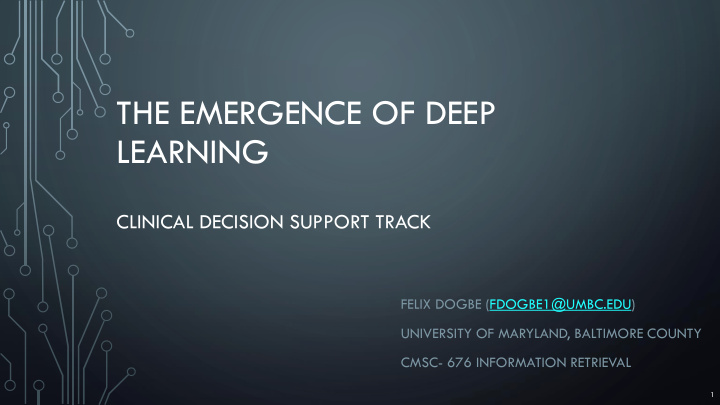



THE EMERGENCE OF DEEP LEARNING CLINICAL DECISION SUPPORT TRACK FELIX DOGBE (FDOGBE1@UMBC.EDU) UNIVERSITY OF MARYLAND, BALTIMORE COUNTY CMSC- 676 INFORMATION RETRIEVAL 1
QUICK HISTORY ARTIFICIAL MACHINE LEARNING DEEP LEARNING INTELLIGENCE(A.I) Present Day 1950s -1970s 1980s -2010s 2
Image from: https://rapidminer.com/glossary/machine-learning/ 3
CATEGORIZATION OF DEEP LEARNING • Deep network for Supervised Learning: • is a learning process where the training set is labeled. • Deep network for Unsupervised Learning: • is a learning process where the training set is not labeled. • Hybrid Deep network • Both generative and discriminative components • Combination of both labeled and unlabeled. 4
NEURAL NETWORKS Neural Networks are computing systems with interconnected nodes that work much like neurons in the human brain. Example of Neural Networks; CNN – convolutional neural network RNN – recurrent neural network FFN – feedforward neural network The number of neurons in the input and output layers is determined by the type of input and output your task requires. For example, the MNIST task requires 28 × 28 = 784 input neurons and 10 output neurons. 5
TENNESSEE TECH PHOTOS… 6
CLINICAL DECISION SUPPORT • Providing useful precision medicine-related information to clinicians treating their patients. • The ability to quickly locate relevant information for a current patient using information retrieval (IR) has the potential to be an important tool for helping clinicians find the most up-to-date evidence-based treatment for their patients. 7
APPLICATION OF DEEP LEARNING-CDS • Computer technology can assist by generating case-specific advice for clinical decision making. There are some programs that are able to diagnose a patient illness based on his/her symptoms and other past medical history. It can also recommend a course of treatment with very high accuracy. E.g MYCIN • Medical Image Analysis for radiology Original MRI image can be used as input for deep learning machines in order to train the machine/neural network to diagnose brain cancer or tumor in its early stages with high accuracy. 8
FUTURE WORKS WITH DEEP LEARNING • Creation of more synthetic data for research purposes using deepfakes. • Transfer Learning – to build upon pre-existing deep learning models or NN. • Make life way easier and more productive. • Easy diagnosing of other health problems with higher accuracy. • the perfection of self driving cars. • Increase in research involving deep learning. • Deep learning tools will be embedded in every design surface as it becomes ubiquitous and advances. E.g apple watch • Solve more complex computational problems 9
QUESTIONS ? ? ? 10
REFERENCES! • TREC 2019 Deep Learning Track Guidelines.” TREC -2019-Deep-Learning, microsoft.github.io/TREC- 2019-Deep-Learning/ • https://microsoft.github.io/TREC-2019-Deep-Learning/ • “TREC Tracks.” Text Retrieval Conference (TREC) Home Page , trec.nist.gov/tracks.html. • https://trec.nist.gov/tracks.html • “TREC Precision Medicine / Clinical Decision Support Track.” TREC Clinical Decision Support Track , Kirk Roberts, William Hersh & Steven Bedrick, www.trec-cds.org/. • http://www.trec-cds.org/ 11
Recommend
More recommend